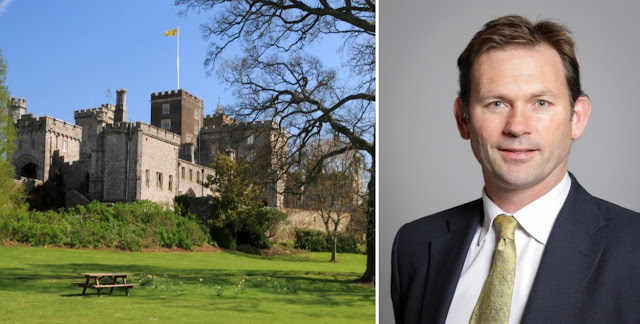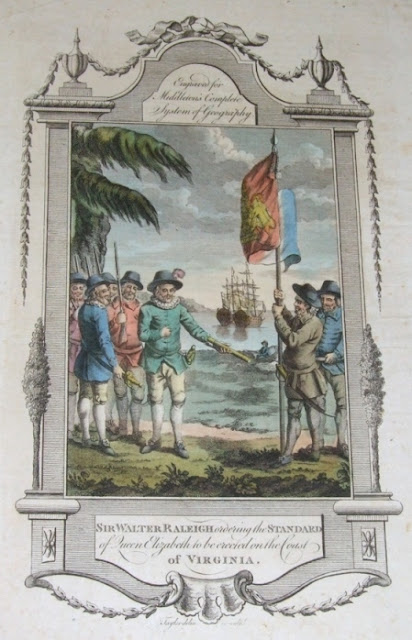AROUND THE TOWN AND OVER THE POND - 03: ‘OF BIKES, POTATOES, PIPES, PAINTINGS AND OTHER MYTHS’
Continued from https://budleighpastandpresent.blogspot.com/2024/05/around-town-and-over-pond-02-boyhood-of.html
AROUND THE TOWN AND OVER THE POND
A walk around Budleigh Salterton to interest transatlantic visitors. Every so often there’s a diversion which may inspire you to visit places like East Budleigh, Exeter, Sidmouth, Colyton or even places in the United States and Canada.
The walk is set out in parts. Here’s the third part:
At the Raleigh Wall.
0.3 ‘OF BIKES, POTATOES, PIPES, PAINTINGS AND OTHER MYTHS'
Image credit: Wikipedia
Think of Raleigh and many British people today would think not of Sir John Everett Millais and his dream of Sir Walter’s boyhood but of bikes.
The Raleigh bike company was actually named after Raleigh Street in Nottingham. It was founded in 1885 by a Briton, Richard Morris Woodhead, and – of all things – a Frenchman called Paul Eugene Louis Angois.
And before you ask, yes, Raleigh Street in Nottingham was named after Sir Walter in common with quite a few other British towns which have named streets or roads after him including Bedford, Coventry, Haringey in London as well as the London N1 district, Poole, Richmond in Surrey. And of course in Devon - Dartmouth, Exeter, Exmouth, Ottery St Mary, Plymouth, and Budleigh Salterton - where Raleigh Road runs off East Budleigh Road, as shown above.
Image credit: Wikipedia
Some people believe that Sir Walter invented potatoes. It’s true that an American-bred potato is named after him - described in this advertisement as 'the best Potato we have ever tried' by a 'Rural New-Yorker'.
I tried to get a Devon chip manufacturer to launch a brand called ‘Wallies’ in time to mark the 400th anniversary of Sir Walter's death, but without success.
Image credit: Wikipedia
This contemporary painting of the Great Famine in Ireland caused by potato blight was entitled 'An Irish Peasant Family Discovering the Blight of their Store' and exhibited in London in 1847.The painter was Daniel Macdonald (1820-1853), a young Irish artist recently arrived in Britain. It is notable that the painting barely merited comment at the time.
At a talk I gave in East Budleigh a man in the audience told me that Raleigh was responsible for the deaths of thousands of Irish people in the 19th century. I was so surprised and dumbstruck for a few moments that I forgot to stand up for Sir Walter and potatoes by suggesting that the humble vegetable might have kept many more Irish people alive over the centuries.
The monument commemorating the Smerwick Harbour massacre. Image credit: www.geograph.org.uk
Strangely, the man in that East Budleigh audience failed to mention how Raleigh was blamed – perhaps unjustly – for the massacre of Irish rebels along with Italians and Spanish soldiers at Smerwick. According to the poet Seamas Heaney, the ground was ‘sowed with the mouthing corpses of six hundred papists’.
Image credit: Imperial War Museum
Some people might also believe that Sir Walter was
responsible for lung cancer because of his discovery of tobacco. These cigarettes were produced during WW2 by Brown & Williamson
Tobacco Corp. from Louisville, Kentucky. The back of the package shows an
advertisement to buy War Bonds and Stamps for Victory.
Image credit: www.artuk.org
Speaking of which, I love this painting by the Scottish artist Ronnie Heeps. From Raleigh’s smoky breath comes a line of ships exploring the stars. And at the bottom right you see a space rocket taking off. From Cape Canaveral perhaps?
Powderham Castle, home of the Earl of Devon
Charles Courtenay, 19th Earl of Devon, owner of Powderham Castle, whose family was distantly related to Raleigh’s, told me: ‘Sir Walter Raleigh is a hero to every Devonian with a wanderlust and a sense of adventure – we should all make a pilgrimage to the Raleigh Wall in Budleigh Salterton. A copy of the Boyhood of Raleigh hangs on my son’s bedroom wall. A reminder of times when local Devon sailors pushed the bounds of the known world and when our rugged coastline was the Cape Canaveral of its day.’
I wondered whether he had seen
that painting by Ronnie Heeps.
Professor Brent Lane at the tomb of Sir Walter Raleigh in St Margaret's Church, Westminster
A scholar of Raleigh and of entrepreneurial
finance, an American economics professor based at the University of North
Carolina, has researched parallels
between Sir Walter's 16th century sea voyages and 21st century space
exploration. Professor Brent Lane is
interested in the lessons that Elizabethan entrepreneurial explorations offer
to modern commercial space entrepreneurs like Jeff Bezos, Elon Musk and Richard
Branson.
I don’t know whether Raleigh is one of Sir Richard Branson’s heroes, but Virgin Trains certainly has a locomotive, no. 221113, named after the Great Elizabethan.
This painting of Raleigh with a Molyneux globe by an unknown artist was displayed at the Velvet Cloak Inn at Raleigh, North Carolina. Seen right is the Molyneux globe at Petworth House, Sussex. Image credit: David O'Doherty
To finance the incredibly expensive expeditions which he organised, the talents of the modern entrepreneur were what he needed.
For Raleigh, the backing of financiers like William Sanderson (c1548-1638) was vital to ensure that investors in the City of London would support his plans for colonies in the New World.
It was Sanderson, a member of the City of London Fishmongers’ Livery Company and married to Raleigh’s niece Margaret Snedale, who had sponsored and managed the voyages undertaken by the navigator John Davis in search of the North West Passage in Northern Canada. He also provided funds for the mathematician and instrument maker Emery Molyneux to construct the first globes made in England.
'The School of the Night' © Ronnie Heeps
Image credit: www.artuk.org
‘The Smoker’ is one of a series that artist Ronnie Heeps called ‘Dreaming beyond the Medieval’. Here’s another, entitled ‘The School of the Night’, the title being a modern name for a group of men centred on Sir Walter Raleigh that was once referred to in 1592 as 'The School of Atheism. The group supposedly included poets and scientists Christopher Marlowe, George Chapman, Matthew Roydon and Thomas Harriot.
'Wee Raleigh Star Commander' © Ronnie Heeps
Yet another painting by Ronnie Heeps with the title ‘Wee Raleigh Star Commander’, taking up the space exploration theme.
Inspired by Raleigh’s life story, the artist explained in 2006 that he wanted ‘to try and show the inner workings of a true maverick spirit completely embroiled in the zeitgeist of his day’.
'The Quest for Eldorado' © Ronnie Heeps
Sir Walter Raleigh, he wrote, ‘excelled in numerous fields and was able to cross between the disciplines of art, science and philosophy with ease. Such a proficiency in study exemplifies the Renaissance man. The ability to comprehend and bring together many disparate ideas enabled him to formulate a worldview, which had eluded many great medieval intellectuals.'
‘Raleigh was not afraid to undertake daring deeds and dream of glorious multifaceted worlds, which lay just beyond the horizon of conventional thought,’ Ronnie Heeps continued. ‘He could comprehend a future world that was not a preordained construct. A future world, which was in a constant state of flux and therefore open to the influence of secular thinkers.’
'Elizabeth I Commissions Raleigh to Sail for America, 1584' by Alfred Kingsley Lawrence (1893–1975), from the Parliamentary Art Collection. Image credit: www.artuk.org
So what’s the connection with America, and especially with the US? For some people it’s so close that they imagine him setting out across the Atlantic to claim land for his Queen. That seems to be hinted at in this painting by the English artist Alfred Kingsley Lawrence (1893–1975), pictured above.
'Sir Walter Raleigh ordering the Standard of Queen Elizabeth to be erected on the Coast of Virginia.' Engraved for Middleton's Complete System of Geography. Image credit: www.rmg.co.uk
The 18th century publisher of this engraving certainly believed it.
Raleigh actually never set foot in North America. But he
organised attempts to colonise it, sending people like the geographer and
artist John White to survey it and report back with glowing descriptions of
what a fantastic place it would be in which City of London merchants could invest. His remarkable watercolours are part of the British Museum's collection.
Click on the link to continue in Part 4 at
https://budleighpastandpresent.blogspot.com/2024/06/around-town-and-over-pond-04-diversion.html


_(16460959319).jpg)



















Comments
Post a Comment